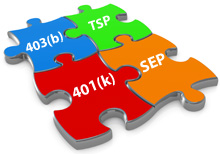 |
||
|
Stifel Client Account Access: LOG IN ● 1 Consolidate 2 Manage 3 Retire Well ● Contact Us |
||
|
|
||
| ROLLOVER CENTER |
ROLLING AFTER-TAX 401K DOLLARS INTO TRADITIONAL IRAS
Does your 401K contain ďafter-taxĒ voluntary contributions, and are you
planning to roll over your plan assets into a Traditional IRA?
If so, itís important to know the long-term bookkeeping
responsibilities Traditional IRA owners assume if after-tax dollars are
rolled into Traditional IRAs.
QRP pre-tax vs. after-tax tracking
In a
401K or other type of QRP (Qualified Retirement Plan), it is generally the
Plan Administratorís responsibility to determine and track pre-tax vs.
after-tax dollars held and distributed for that planís participants.
Thus, while assets are held within a plan, plan participants have
no tracking or IRS reporting responsibilities.
When a
401K participant terminates employment and requests a distribution, their
QRP administrator informs them of their plan balance, which must detail
pre-tax vs. after-tax assets held.
IRA pre-tax vs. after-tax tracking
Generally, most
institutions do not keep track of after-tax dollars held in IRAs.
IRA owners are
responsible for tracking any after-tax dollars, and unlike QRPs, the
responsibility to account for after-tax contributions includes combining
the value of all of the individual's IRAs.
IRA owners must combine the balance in every IRA, except Roth IRAs,
and track any after-tax amounts as a ratio of the total balance of all the
IRAs. IRA owners, and beneficiaries after an ownerís death, must continue
the tracking process until the IRA assets are completely distributed.
After-tax
reporting is carried out by filing an IRS Form 8606,
Nondeductible IRAs,
with oneís tax return. And, a
Form 8606 must be submitted to the IRS every year there is a change in the
after-tax basis.
Taxable vs. non-taxable IRA distributions
Once after-tax dollars are received into an IRA, IRA owners are not
permitted to take just after-tax distributions from any of their IRAs.
A formula must be applied to each distribution to determine the
taxable and non-taxable portion of each distribution.
As an example, an IRA owner has a total of $50,000 in all IRAs,
which consists of $47,000 pre-tax and $3,000 after-tax dollars.
His after tax amount is 6% of his total.
So, If an IRA owner takes a distribution of $4,000, the after-tax amount
and reduced basis would be calculated as follows:
$3,000 (after-tax balance) divided
by $50,000 (total of all IRAs) times $4,000 (distribution amount) = $240.
The $240 represents the non-taxable portion of the $4,000
distribution and reduces the after-tax basis from $3,000 to $2,760.
This procedure must continue for every distribution taken, and itís
important to note that an IRA owner must keep complete and accurate
records to avoid incorrect tax filings.
Receive or Roll Over? Plan participants have the option to receive or roll over after-tax dollars into IRAs. By rolling, the tax-free assets continue to shelter new tax-deferred growth. However, IRA owners assume tracking and reporting responsibilities. On the other hand, plan participants who receive their tax-free dollars outside an IRA avoid the issue. Which is the best way to go? Your tax advisor or CPA should be the one to help you make this decision. For more information on rolling over your 401K after-tax dollars into an IRA please take a minute to order a Rollover Kit. |
Your Life. Your Money. Take Control Today! |
| Rollover Center Home | ||
| 401k ROLLOVERS | ||
| Order Rollover Kit | ||
| What is a 401k Rollover? | ||
| How Do I Start a Rollover? | ||
| ROLLOVER IRA s | ||
| Traditional IRA | ||
| Roth IRA | ||
| Which IRA is Best? | ||
| Investment Options | ||
| Contribution Limits | ||
| PLANNING | ||
| Retirement Planning | ||
| Estate Planning | ||
| Wealth Tracker | ||
| Wealth Strategist | ||
| RESOURCES | ||
| Search FAQs | ||
|
About Us |
||
|
|
||
 |

